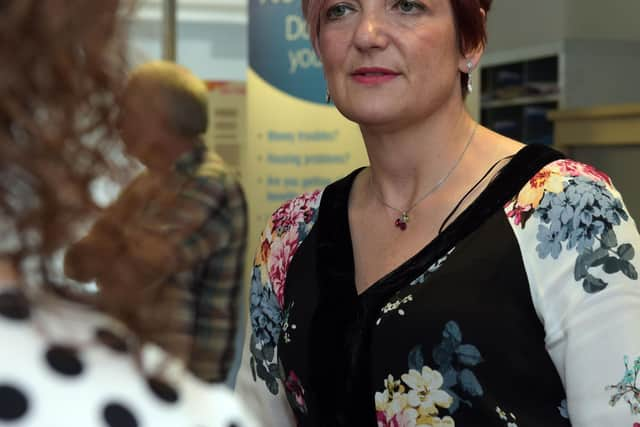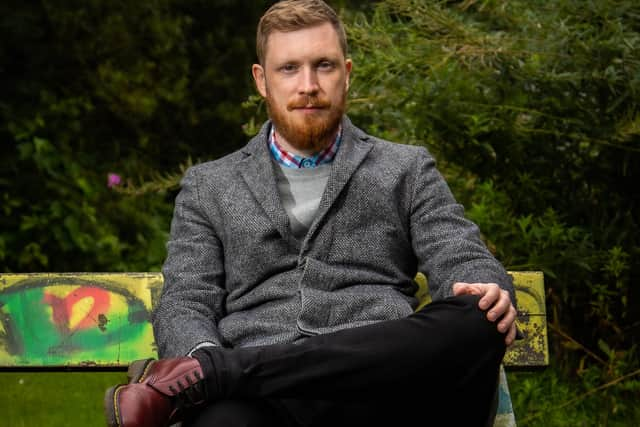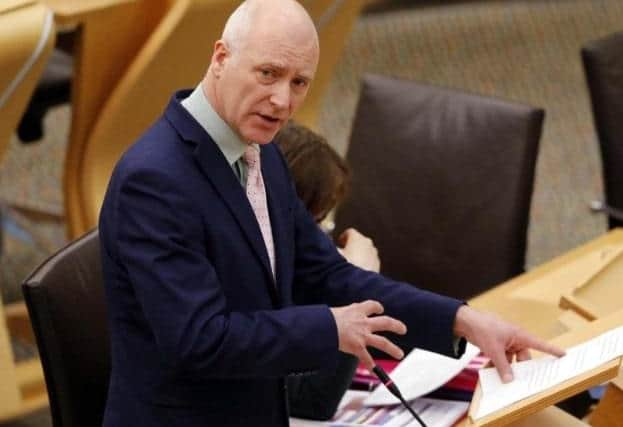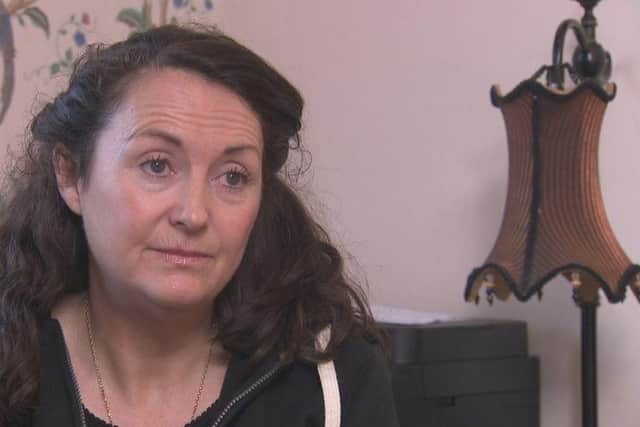Insight: One mother's story and the scandal of Scotland's drugs death crisis


Mark, 27, had been estranged from his family for a couple years. Kirsty heard bits and bobs about his life on the local grapevine, though. She knew he had been jailed for an assault in a nightclub; and that he had been released. She thought perhaps he’d turn up over the festive period, but Christmas Day came and went without a chap on the door.
On Boxing Day, she had gone out to feed some donkeys, and returned to find a card from Police Scotland on the mat. “I panicked. I thought: ‘Oh, God - what has he done now?’” she says. But when the officers turned up later, it was to tell her Mark was dead. He had taken drugs at a party. A friend had phoned for an ambulance, but, by the time it arrived, he was already gone.
Advertisement
Hide AdAdvertisement
Hide AdMark had been in and out of trouble since he was 14, dodging school and smoking cannabis. At the mortuary, she was told a post mortem would be carried out and a toxicology report filed. But there was a backlog; the process was likely to take six months.


This was before the pandemic. When Covid struck, the backlog grew. It was October before Kirsty received the results: Mark’s death had been caused by a combination of methadone and Etizolam - a type of street valium.
This came as a shock to Kirsty. Mark had not been a heroin user, nor - to the best of anyone’s knowledge - was he on a methadone script. “The police suggested that maybe he had been able to get access to methadone in prison,” Kirsty says. The prison methadone would likely have been less potent than the methadone he bought on the outside. Ditto the etizolam, which is often peddled as diazepam, but is 10 times stronger.
Kirsty makes no excuses for Mark, “an articulate boy with lots of opportunities which he didn’t take.” But she is still upset about the way he was treated. “I went to his flat after his death and there was nothing in it,” she says, “just a quilt with no cover, and pillows with no pillow cases. He was vulnerable. Who was looking out for him? Why didn’t they try to get in touch with me? Was there any attempt to link him to services?”
Kirsty is also angry about the toxicology delays. “I went to counselling after Mark died and they kept asking: ‘Have you heard anything from the fiscal’s office?’ because they thought that might bring me closure.’


“Even now, I haven’t been given his clothes and belongings back. No-one seems to understand how traumatic this is for relatives.”
Kirsty is by no means alone in her fury. The drug deaths statistics for 2019 - finally published on Tuesday - were no less disturbing for having been anticipated, and prompted an immediate backlash. By Friday, public health minister Joe FitzPatrick - who faced a motion of no confidence - had been forced out.
The public reaction was justified. Scotland’s drug deaths rate was already the worst in Europe. When the figures for 2018 came out, the SNP declared a national emergency and set up a taskforce to reverse the trajectory. And yet the toll had risen again. The number of deaths in 2019 was 1,264 - an increase of 6 per cent, year on year, and triple the figure for 2006.
Advertisement
Hide AdAdvertisement
Hide AdScotland’s drug deaths rate now stands at 231 per million, 3.5 times the rate in England and Wales. Each of the 1,264 was - like Mark - a son or daughter, a brother or sister; a loss to their community. Their families demanded answers. Opposition politicians pointed to heavy funding cuts, patchy treatment services and a lack of residential rehab as evidence of catastrophic political failure.


It didn’t help that FitzPatrick appeared unchastened and out of his depth; or that many critics believe the SNP has politicised the crisis, weaponising Westminster’s refusal to scrap the Misuse of Drugs Act in its pursuit of independence. Labour MSP Neil Findlay points out there is plenty the Scottish government could be doing with its existing powers, and says its focus on the Home Office’s attempts to block a drugs consumption room (DCR) in Glasgow is a deflection from its own failures.
Findlay, who lives in West Lothian, also claims the Scottish government’s response to the pandemic has exposed its relative indifference to the lives of users. “If you look at the extraordinary amount of money that has been spent on Covid and the piffling amount of money that has been spent on addressing the drugs deaths, I think you can set into context how much of a priority stopping people dying is when they are poor and disenfranchised,” he says.
At FMQs, Nicola Sturgeon accepted the toll was indefensible and that there was much more her government needed to do. She did not seek to make excuses. Within 24 hours, FitzPatrick had been replaced by Angela Constance.
And yet, there is no getting away from the fact that, in the 13 years the SNP has been in power, the number of deaths has tripled. FitzPatrick was appointed in 2018, when the problem had already spiralled out of control. It will take more than his departure to prove the First Minister is taking this seriously.


Kirsty says three more young men from Mark’s school year have died drug-related deaths since his fatal overdose. “I heard Sturgeon speak and I want to be positive,” she says, “but I’m finding it hard. The fact is, unless this is sorted, I will never vote SNP again.”
So: why do Scotland’s drug death figures keep on rising ? Well, the first thing to say is that it’s complicated. Last week, some SNP supporters - including MP Angus MacNeil - shared an image which suggested our drug death rate was only higher than England and Wales because of a difference in the way drug deaths are counted here. This claim was long ago debunked. What is true, however, is that the pattern of drug consumption here is riskier than elsewhere in the UK, with users commonly mixing opiates such as heroin and methadone with benzodiazepines.
“For 40 years, people in Scotland have used benzodiazepines either to enhance the effect of the opiates or to mitigate the effects of withdrawal. In the 80s/ 90s it was temazepam, in the 90s/noughties, diazepam,’” explains Andrew McAuley, reader in public health epidemiology at Glasgow Caledonian University.
Advertisement
Hide AdAdvertisement
Hide AdUntil 2015, most of the “benzos” in circulation were diverted prescriptions, which meant that, while taking them alongside other substances was still risky, there was a degree of quality and consistency.
However tighter controls over prescriptions introduced in 2009/10 created a market for illicit “street benzos” - known as “bluies” - which can be bought for 50p a pill and are often consumed not in ones or twos but by the handful.
“What happened was, we interrupted the supply without thinking about the demand,” says McAuley. “We introduced controls on prescriptions at a time when drugs like benzodiazepines were becoming much more available via the internet and - like any gap in the market - entrepreneurs found a way to fill it.”


Etizolam currently dominates the street benzo market. “It seems to have had a much bigger effect on the mortality rate than any other benzo to date,” McAuley says.
This is borne out by the 2019 figures. While opiates and methadone were also implicated in the majority of the 2019 deaths, street benzos contributed to 814, of which 752 involved etizolam.
Linda Weir - a recovering heroin addict, who works as a peer support practitioner with Turning Point Scotland - says her hometown of Kilmarnock is awash with street benzos. “Four people on my street deal them,” she says. “No matter where I go, I get offered them. When I was on my way to the shops the other night, a guy I know had a big bag of them. He said: ‘Do you want any valium?’ I said: ‘You know I don’t use anymore.’”
Weir has lost count of the number of deaths over the last six months. “People are dropping like flies,” she says. A fortnight ago, a former school friend was found dead after police broke down the door of her flat. “They said there were street benzos lying beside her.”
Weir was upset, but not surprised. Weeks earlier, the friend had confided that her prescription for valium had been stopped because she had tested positive for heroin. “She said she had started to buy street valium. I told her it was dangerous.”
Advertisement
Hide AdAdvertisement
Hide AdWeir’s friend said she had sought help from the prescribing centre, and then from her GP, who sent her back to the prescribing centre.
“This is the problem,” says Weir. “There are so many agencies. They should all work together, but a lot of the time they bounce you from pillar to post. The problem is, if you have a chaotic lifestyle, you don’t have the capacity to go from pillar to post. You need one person that can say: ‘Here’s what we can do for you’.”
Weir’s job involves building a relationship with difficult-to-reach users. She haunts alleyways and underpasses, trying to gain their trust. But even if she persuades them to engage with services, help is not always available.
NHS Lothian has piloted same-day access to methadone, but in some parts of the country it can take weeks or even much longer to get a prescription. Weir says: “I don’t understand why - when someone is asking for help - they can’t say: ‘This is a matter of life or death. Let’s intervene right now and get them the help they need.’ But they don’t - they turn people away.”
Weir’s exasperation is echoed by other users and drug workers, who have seen too many people die. They say multi-million pound cuts to the Alcohol and Drug Partnerships (ADPs) back in 2016 left the treatment system unfit for purpose.
“We know if you have an optimal system that is able to engage and retain people in treatment, you can make significant gains in preventing drug deaths,” McAuley says. “But when you compare Scotland to its domestic and European counterparts, we perform very poorly. Just 40 per cent of our problem drug user population is engaged in drug treatment compared to 60-65 per cent elsewhere in the UK, and 80-85 per cent in Norway.
“We also have a poor record of retention. There is lots of evidence that people are cycling in and out of treatment. When they do that, their tolerance levels go up and down, and when their tolerance level is low, they are much more likely to overdose if they relapse.”
What is stopping our drug users from engaging? “Services have to meet people at their point of need and they have to offer a range of alternatives because there is not a single treatment pathway,” McAuley says.
Advertisement
Hide AdAdvertisement
Hide Ad“They need to offer not just methadone, but also buprenorphine and buvidal, which lasts for a longer time so people don’t have to go to the chemist every day. The services have to be more flexible, not just office hours.
“To be fair on them, though, many of the things that were crucial to engaging and retaining drug users - the wrap-around care, the people who help with benefits and training - were stripped away, leaving only the core drug treatment staff who deal with an individual’s prescription.” Without that care, it is difficult for users to achieve stability, and so they drift away.
Some observers say the 2016 cuts were made in the belief that Scotland’s ageing cohort of heroin addicts would soon die off; but younger drug users have kept appearing and their behaviour has become riskier. The treatment system, designed around heroin addicts, has failed to adapt to increasingly toxic polydrug use, or to the sudden rise in the injecting of cocaine.
There have been cuts to residential and community-based recovery services too. At FMQs Sturgeon confirmed that, of the 365 available rehab beds in Scotland, 100 of them were being taken up by patients from other countries.
“In Scotland, we are relying on third sector services that are cut to the bare bones and don’t have the capacity to bring enough skilled workers particularly with lived experience, “ says Aidan Martin, a former cocaine addict, advocacy worker and author of the memoir, Euphoric Recall. “We are relying on Mutual Aid Fellowship meetings to get people clean and keep them clean.”
Martin stopped using a few years ago after a volunteer at West Lothian Drug and Alcohol Service encouraged him to go along to recovery meetings, but he accepts “recovery” means different things to different people. “If you have someone who is still very much involved in chaotic drugs use, a fellowship is unlikely to be for them,” he says, “but abstinence based recovery does work for some people.”
Annemarie Ward, founder of Faces and Voices of Recovery UK, says Glasgow spends a total of £47m on addiction services, but only £500,000 of it goes on abstinence-based residential rehab.
“What has happened is the system has become so focused on the crime reduction dividend from methadone they can see no other way - and the whole system feeds itself,” she says.
Advertisement
Hide AdAdvertisement
Hide Ad“We are spending half a million on getting people off drugs and helping them rebuild their lives, and £46.5m on harm reduction initiatives. Those harm reduction initiatives are great. I would say ‘keep doing that’. But also give people the opportunity to get well because that mantra of ‘keep them alive, keep them alive’ isn’t good enough. As a person in long-term recovery, I see it as a lack of ambition. It’s disrespectful to assume I am not worthy of healing.”
As the yearly death toll has continued to rise, the Scottish government has made some efforts to change course. It has replaced much of the funding it cut in previous years, and, in July 2019, it set up the Drug Deaths Taskforce chaired by Professor Catriona Matheson.
Inevitably it has its critics; some view it as a talking shop, and complain its projects serve to line the pockets of those working in the “addiction industry.
In the 18 months it has existed, it has overseen the expansion of Scotland’s ground-breaking naloxone programme, which has empowered family members and frontline workers to administer the antidote to a heroin overdose. Most recently, it funded a trial in which those who were treated for a heroin overdose , but declined to attend hospital were given a naloxone kit.
The taskforce is also carrying out a consultation on Medication Assisted Therapy (MAT) standards, with a view to improving the service and increasing consistency across the country.
Meanwhile, the Glasgow City Health and Social Care Partnership has opened a heroin assisted treatment facility in the city centre for chronic users who have not benefited from other interventions. It’s a pioneering service, but is treating such a small number of users it is unlikely to have a significant impact on the drug deaths figures.
Other potentially positive changes - things activists have long campaigned for - have come about inadvertently as a result of Covid-19. Rough sleepers were accommodated overnight, lots of people were put on take-home prescriptions, and digital and postal services were set up so people could access harm reduction material online.
Yet so much more is still to be addressed. And the pandemic is likely to have a negative legacy, as those affected by the economic fallout turn to substance abuse as a coping mechanism. Sturgeon (and Constance) will have to act quickly if further disaster is to be averted.
Advertisement
Hide AdAdvertisement
Hide AdWhen people talk about the way Portugal turned its drug epidemic around, they tend to focus on the decriminalisation which allowed substance abuse to be treated as a health rather than a criminal justice issue; and, of course, that principle is at the heart of the system.
But when I visited in autumn 2018 what struck me most was the political consensus around the approach and the integrated service system it produced. Over the last 40 years, governments of different hues have come and gone, but no party has pushed for a fundamental change in direction .
In Scotland, the pendulum has swung back and forth between harm reduction and abstinence-based recovery - as if the two were rivals fighting for control, rather than twin pillars of a joined-up, holistic treatment system.
Harm reduction is currently in the ascendancy, and the false dichotomy persists. Some advocates of abstinence-based recovery will refer to users being “parked” on methadone, while
some harm reductionists claim residential rehab is too expensive and leads to relapses. McAuley claims this polarisation is both unusual and damaging. “I have worked with drug experts from many other countries and they are baffled by it,” he says.
The other issue peculiar to Scotland is the conflict between the powers reserved to Westminster and the powers devolved to Holyrood. The Scottish government would like to follow Portugal’s lead and treat drug addiction as a health issue, but the power to decriminalise lies with Boris Johnson.
The Scottish Affairs Committee lobbied hard for a change in legislation which would enable Glasgow to open a DCR to address overdoses and its HIV epidemic. However, the Home Office refused, allowing SNP to blame Westminster for the stasis.
Then along came Peter Krykant with his drug consumption van to challenge the narrative. Operating for a few hours a week in Glasgow city centre, Krykant knows he can’t reverse the drug deaths figures. But he hopes that - like a similar civil action in Denmark - his van will lead to a change/clarification of the law and the opening of permanent DCRs across the country.
Advertisement
Hide AdAdvertisement
Hide AdAttracting public and press attention, Krykant has become a one-man provocation to the Scottish government: to stop passing the buck, to be bolder, more ambitious, and to treat the drug deaths as a national emergency in deed as well as word.
Of course, it will take more than ambition to end this crisis; it will take resources. To illustrate what can be achieved when you wholeheartedly commit to tackling a problem McAuley and others point to the Scottish government’s response to excess alcohol consumption.
“The catalyst was a famous graphic that showed alcohol-related liver disease was higher for females in Scotland than it was for males in England and Wales,” McAuley says.
That graphic - published in the mid 2000s - proved a seminal moment. Resources were mobilised, new policies adopted. Now, 15 years on, the alcohol statistics continue to move in the right direction.
“There’s been a lot of talk about drugs, and there’s been some good stuff done here and there, but I don’t think we have ever had a fully coordinated resourced response,” McAuley says.
Kirsty too is frustrated by the lack of urgency. “Everything was mobilised for Covid and I was impressed by that, but the drug deaths are a pandemic too,” she says. “I would like to see the same degree of mobilisation with realistic funding and support for those at coal face. And I think the Scottish government should be putting something out to the public on a weekly basis to keep it at the forefront of people’s minds. Just now, there’s no context. Once a year, it’s just - ‘all these people died - now let’s move on’.
“To someone like me, who has lost a son, it seems some lives are considered more important than others.”
*KIrsty’s name has been changed to protect her identity